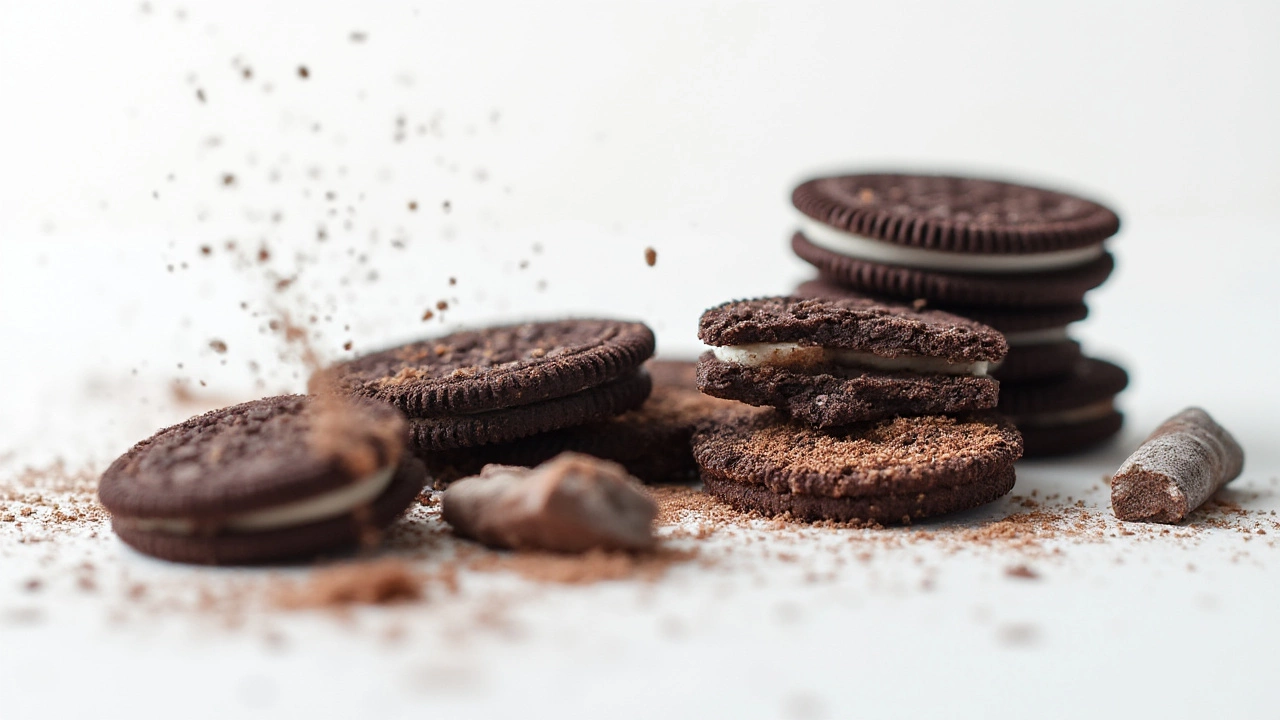
Pop open a blue package, twist, lick, dunk—and then the question creeps in: are Oreos vegan or is it just clever marketing and wishful thinking? This debate follows the black and white cookie everywhere it goes. The rumor mill spins stories: that Oreos are made with pig fat, contain mysterious milk powders, or that a single bite will have you breaking decades of plant-based commitment. But what’s really inside that famous cookie? Let’s get right into the crunchy, creamy truth, leaving no crumb behind for confusion or myth.
What’s Actually in an Oreo?
Check out the ingredients list on a pack of classic Oreos. No milk, no eggs, no honey—so does that make it vegan? Here’s what you’ll find: sugar, unbleached enriched flour (wheat flour, niacin, reduced iron, thiamine mononitrate, riboflavin, folic acid), palm and/or canola oil, cocoa, high fructose corn syrup, leavening (baking soda and/or calcium phosphate), soy lecithin, salt, chocolate, and "artificial flavor." On paper, nothing screams "not vegan." The cookie’s creamy center looks dairy-rich, but there’s no butter, and the fat comes from plant oils. That’s why, when lists of "accidentally vegan" snacks go viral, Oreos are always right there, sandwiched between Skittles and Ritz crackers.
Here’s where it gets sticky: While Oreos don’t use animal-derived ingredients in the U.S. and many other countries, manufacturers openly admit to a risk of cross-contact with dairy. Nabisco, the company behind Oreos, explicitly states on their FAQ (as of 2025) that the cookie is not intended for vegans because of milk cross-contact in production facilities. In other words, no milk goes into the recipe, but some could slip into the mix during manufacturing. If you’re highly allergic or an absolute purist, this could be a deal-breaker.
Then again, dig through ingredient lists from around the world and you’ll spot differences. In the U.K., for example, Oreo’s recipe is nearly identical, but sometimes local flavors—or limited-edition Oreos—bring in ingredients that aren’t plant-based. In some places, Oreos used to include whey, which is derived from milk, but the classic recipe stateside has ditched dairy entirely for decades. The U.S. and Canada varieties, especially, have held steady with their accidental vegan status.
Wonder why Oreos taste so good? The magic is in that "chocolatey" center. It’s made from sugar, oil, and a secret blend of flavors that mimic the richness of dairy cream without a drop of actual milk. Palm oil is a big part of that process. This raises another food debate: while the cookies are dairy-free, palm oil production has its own ethical and environmental discussions, like threats to orangutans and rainforest deforestation. Some vegans choose to avoid palm oil, so even if an Oreo is technically plant-based, it might not align with every vegan’s values.
Busting the pig fat myth: This persistent rumor is pure fiction—the modern Oreo is completely free of lard and always has been since the 1990s. Animal fats were used in early 20th-century recipes, but those days are long gone. If you’re worried about sneaky animal products, breathe easy—today’s Oreo owes its richness to plant oils and cocoa, not hog fat.
Why Do People Think Oreos Aren’t Vegan?
Blame it on the creamy center. That snow-white filling screams dairy at first glance, and the food industry’s history makes people wary. Between mystical "natural flavors" and food dyes hiding all kinds of molecules, people don’t trust a label as far as they can throw it.
Some suspicion comes from Oreo’s own website, which warns about milk cross-contact. This soundbite shows up everywhere. It’s less about the ingredients themselves and more about how the cookies are made: Oreos are produced in facilities that also handle dairy products, so there’s a slim chance a few cookie crumbs share equipment with something containing milk. That legal note is about allergy risk more than intentional milk use. If you flip the box over in the grocery store, you’ll almost always see: "May contain milk." For someone with a severe milk allergy, even a trace can be dangerous. But for most plant-based eaters, "may contain" doesn’t mean "does contain."
But there’s another twist—regional formulas and special editions. Not every Oreo you see is the same. Nabisco rolls out wild new Oreo flavors every season: birthday cake, carrot cake, peanut butter, red velvet, lemon, the list goes on. Some limited-time-only and region-specific recipes use non-vegan colors, gelatin (rarely), or shared dairy equipment. If you’re unsure, best to scan every ingredient list for every flavor before you bite in.
Dye debate pops up with food colorings, mainly with red 40 and yellow 5. These dyes themselves aren’t animal-derived, but vegans with a stricter stance may avoid them due to animal testing associated with their safety certifications. While most Oreos stick to basic black and white, those brightly colored creams in seasonal packs might leave you with questions that don’t have a clear answer.
For an extra pinch of realness, here’s a quick table showing the Classic Oreo ingredients vs. some popular limited-edition ones in 2025:
| Oreo Variety | Contains Dairy Ingredients? | Animal-Derived Coloring? | "May Contain Milk" Label? |
|---|---|---|---|
| Classic Oreo (U.S.) | No | No | Yes |
| Golden Birthday Cake Oreo | No | Possibly (for sprinkles) | Yes |
| Carrot Cake Oreo | No | Possible | Yes |
| Peppermint Bark Oreo (Holiday) | Check label, varies each year | Possible | Yes |
If absolute clarity matters, always check that label, every single time—manufacturers change their recipes faster than you can say "double stuf."

Can Vegans Eat Oreos and Still Feel Good About It?
This is where things get personal. Plenty of plant-based eaters bite into Oreos without hesitation, focusing on ingredient lists and not worrying about "may contain" warnings that are meant for allergy safety, not intentional dairy use. Others set stricter standards, wanting no chance of animal product crossovers, even at levels impossible to see, taste, or measure.
Let’s check out some real-life tips for vegans who want to keep the are Oreos vegan question off the worry list:
- Call the manufacturer if you want a detailed breakdown on cross-contact risk. Nabisco customer service in the U.S. has always been upfront about facility risks and offers updates if processes change.
- Look into specialty vegan cookies for an uncompromised experience—brands like Lenny & Larry’s and Partake make "Oreo-like" sandwich cookies certified 100% vegan, made in dedicated dairy-free facilities.
- If food dyes make you uneasy, stick to the black-and-white classics, skip the neon-colored seasonal packs, and always read the food coloring section of the ingredients.
- For international Oreos, Google the flavor name and country—Red Velvet Oreo in Australia is not the same as Red Velvet Oreo in Canada, and ingredients shift more than you’d think.
- Ethics come into play: do you avoid palm oil, or are you comfortable with the brand’s stance and sourcing policies? Your answer might be different from the next vegan’s.
Here's what happens outside of label reading: Oreos have turned into a kind of vegan comfort food. People in plant-based communities love them because they're widely available, affordable, and offer a taste of the "forbidden" without any animal guilt. Compare that to the decades when vegans had to bake everything from scratch or drive 20 miles to find a vegan treat. Oreos are easy to get—it makes sense they’ve become an edible symbol of plant-based snacking.
There’s no shame in drawing your own boundaries, and plant-based eating isn’t a contest for who’s the "purest." If you’re eating vegan to avoid contributing to animal suffering, Oreos fit the bill for most people. If you’re doing it for allergy or religious reasons, or you need a zero-cross-contact guarantee, hunt down those certified vegan store brands instead.
And don’t forget—if you love dunking, check your plant milk. Some oat milks contain traces of animal-based vitamin D3, and almond or soy milks can get weird additives, so keep reading those labels.
Pro Tips and Fun Facts for Vegan Oreo Lovers
Oreo lovers are nothing if not creative, and plant-based eaters have found tons of ways to work this iconic cookie into every part of life. You’ve probably seen TikToks or Instagram Reels where people blend Oreos into shakes, whip them into vegan cheesecakes, or layer them into banana pudding. Here are some ideas and facts you might not know:
- Freeze your Oreos. They taste like fudge when you eat them cold—extra chewy, and the cream gets firmer.
- Crush them and roll your homemade vegan truffles or energy balls in the crumbs for a crunchy shell.
- Pulse Oreos into fine crumbs and use them as a pie crust base—just mix with plant-based butter.
- Ever tried "Oreo cereal"? Chop up several cookies, throw them in a bowl, and splash on your favorite non-dairy milk for a quick treat reminiscent of those late-night kitchen raids.
Fun stats that might surprise you: as of July 2025, more than 40 billion Oreo cookies are produced each year. Chances are, if all the Oreos made in just one year were stacked, they’d circle the earth five times. That’s a lot of cookies for birthday parties, holiday treats, and midnight munchies.
Oreo’s dedicated vegan following has even led Nabisco to test fully vegan, allergy-safe versions in select markets. In Scandinavia, you’ll sometimes find "Oreo Vegan" varieties with a clear dairy-free certification logo—let’s hope they bring that to everywhere soon.
Thinking of making your own at home? Plenty of food bloggers have perfect copycat recipes using everyday pantry ingredients—flour, cocoa, powdered sugar, coconut oil, and a splash of vanilla. You don’t need fancy gear, and you can even customize the cream’s flavor: peppermint, lemon, matcha, you name it. If you love the classic but crave creative control, DIY Oreos might be a weekend project worth tackling.
Remember, even if Oreos fit neatly into your vegan lifestyle, eating cookies should still be about joy, not stress. The "are Oreos vegan" debate probably won’t disappear fast—but for most people looking at ingredient lists and balance, these cookies can still deliver their twist-lick-dunk magic, plant-based style.